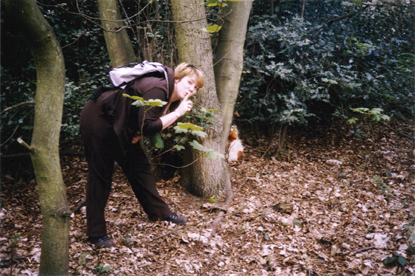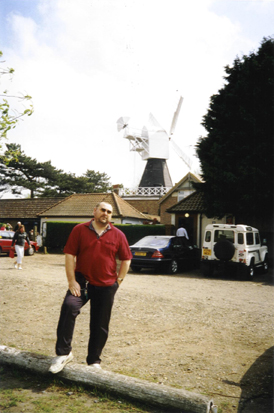| If my memory serves, I have read or heard a report of a wild boar that inexplicably appeared on the common. The fortean in me suggests that, just as the open greenery of Surrey needs a puma and the wilds of Exmoor needs a beast, maybe the universal forces of the world decided that what the dog choked glades and woods of the common really needed was a hairy, fanged pig. I either read this in the Fortean Times or the local paper, I’m sorry I can’t remember more. I think the little fellow got caught and sent to City Farm in Vauxhall. |
Further down the path and deeper in the common are definite signs of witchcraft. Next to what is marked on the map as a “horse exercise ring” is a massive tree. Wrapped around the branches are loads of ribbons and bits of cloth. Sinister it isn’t, I’ve dressed a wishing tree as Borough Market during a 12th Night celebration. The wisher ties a ribbon to a tree to link their desires to a growing entity, to the greater force of nature. I’ve seen ribbons on the Ankerwyke Yew, on a bush near the King Stone at Rollright and weighing down trees in Cyprus and Crete, they’re everywhere. Most people don’t notice them, mostly it just looks pretty, but I like the idea that there are people’s wishes out there, getting blown about, rained on and having the sun shine on them. Spring 2000 and something was found in the horse ring that did upset the locals. Talk from Wimbledon Village Stables, who use the ring, told of a voodoo doll being found there. I heard about it and thought I’d take a look. The doll was made of straw and was found staked to the middle of the ring. I knew a lot less then than I do now (and to be honest, I’m no expert now) but I did know that voodoo dolls were traditionally made of wax, so that snippings from hair and clothes of the intended victim could be worked in. This doll was made of straw. I wandered up to the ring, took some photos of the tree with its ribbons and the rather bedraggled and rain soaked doll which had been thrown into a bush by some nervous equestrian. I showed the photos to a Druid whose acquaintance I’d made. “So was this found recently?” he asked, puffing on his cigar. “Yes” said I. |
|||||
|
They didn't see a boar or a puma on the common, but that is where Sam & Mick first met Alf C. Womble. He lives with them in Knott End nowadays. |
||||||
|
Tramps,
madmen, perverts. Teen and middle-aged couples shagging al fresco, ghosts
and dogs. They’re all the sort of thing you’d expect to find in most open
spaces and woodland. There’s plenty of magic and witchcraft taking place on
the common too. Some of this is just my own impressions though some you
could go and see for yourself. Say you approach the common from the impossibly posh Wimbledon Village, and you’re going diagonally across the village green toward Camp Road. The first thing you’d have to do is pass the Fox and Grapes. It’s a rather good pub which not only boasts the late Ollie Reed as an ex-drinker but also a bomber pilot who crashed on the common during World War Two, climbed out of his plane, staggered to the pub and ordered himself a stiff drink. Anyway, Camp Road is named after a near-by earthwork, Caesar’s Camp. It pre-dates Julius Caesar as far as I know and I don’t think Caesar ever cooled his sandals there. The geniuses of Wimbledon have shown exactly where their priorities lie by sticking a private golf course over most of it. Off of Camp Road is Sunset Road, follow that to a car park and follow the path from the car park to Caesar’s Well. I’m not totally clear on the well’s history, but I think it got its name long after the divine Julius went off to Olympus. It’s a spring, which have been regarded as sacred all through human history. They’re a source of clean water, of course they’d be regarded as holy. The water for a number of fonts in churches are from springs that were pagan sites, usurped by Christians when they were establishing their faith in Britain. I think this one avoided that fate by being out on the common but someone has put a marker around Caesar’s Well. |
“Well the doll is a representation of Brigit, an aspect of the Goddess during Imbolc, the Spring festival. Strange, because a corn and corn dollies are used for Lammas, the harvest festival which is held around the beginning of August. Still, the doll would have been used to celebrate Spring, it’s not anything sinister. She was probably staked to the ground to stop her blowing away during the ceremony.”*
(*The conversation wasn’t much like this at all, the Druid, a bloke called Steve Wilson, chatted a bit about Imbolc and how the doll wasn’t sinister |
Mick Magic on a visit to The Windmill. He and Shona Moments used to like going there on Sunday mornings for a big cup of chocolate and a doughnut. That's why he's so fat, innit? |
||||
|
I’ve sat or stood near the well many times, normally on my own. I‘ve always felt a change of atmosphere there, the air is cooler and has a stillness to it. This, I’d say, is caused by the nearness of the well (though often it’s just a muddy hole with stones around it) and the slight dip around it. There’s a ring of pine trees planted around the well, on the edge of the dip. The rest of the trees on the common are deciduous, that is, they lose their leaves in winter. Someone at some time in the past (they’re pretty big trees) thought to mark off Caesar’s Well from the rest of the common, with evergreen trees. Maybe they’re there to show where water can be found or maybe not. Earth Mysteries author Chris Street once suggested, at a talk I attended, that a ring of trees in St James Park was placed there by stealth Druids for secret ceremonies. Maybe so, and like I said, water has always been regarded as sacred, but maybe people just like to plant trees in a circle. It looks good whatever the reason for its layout and I’d like to know more about it. |
in any way but the Lammas stuff I’ve added to the account in
what some authors call, rather charmingly, an ‘info-dump’. I’ve just got
back from a Lammas
festival
and there was straw-a-plenty and the Lammas 2002 issue of Pagan Dawn has a
whole article on corn dollies. I just thought it was worth mentioning and I
thought putting words in Mr Wilson mouth would be the easiest way of doing
things.. Any ignorance displayed towards pagan ceremony is totally my own
fault.) I blushed, I’d already attended my first Imbolc celebration earlier in the year. It was early for Lammas and it was mainly intended to celebrate the bi-millennium of the Ankerwyke Yew. There was no dolly there, corn or otherwise, but maybe I’d been too busy climbing the tree, drinking mead and getting involved in a Mummers Play to notice. Still, I got to report back to some good Wimbledon folk that black magic, as far as I knew, wasn’t taking place on the common. I could have carried on by telling them that voodoo isn’t really about dolls and curses, it’s a valid fusion of Roman Catholicism and African spirituality, but I think they’d had enough for one day. |
|||||

.gif)
.gif)

